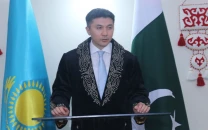India and Pakistan up the nuclear ante
A recent surge of missile tests by the neighbours rings alarm bells in the West

India and Pakistan may be plagued by extreme poverty and lack of education but that does not stop the two nuclear-armed rivals from consciously splurging on nuclear weapons.
“India and Pakistan are increasing the size and sophistication of their nuclear arsenals. Both countries are developing and deploying new types of nuclear-capable ballistic and cruise missiles and both are increasing their military fissile material production capabilities,” said the 2012 yearbook of the Stockholm International Peace Research Institute.
The neighbours are not only increasing the size of their nuclear arsenal, they’re also increasingly showing it off.
The most recent surge of missile tests kicked off with India’s launch of a new long-range weapon capable of hitting China just over six weeks ago; a launch that was subsequently followed by Pakistan’s very own nuclear-capable missile tests – five to be precise. However, the flexibility given to the nuclear-armed neighbours by the West in part exists as the two neutralise each other’s capabilities.
India successfully test-fired the Agni V on April 20, capable of delivering a one-tonne nuclear warhead anywhere in rival China. The test was followed by Pakistan’s test of ‘first-strike’ tactical short-range warheads, which aim to counter India’s superior conventional forces. The last one was the Hatf VII cruise missile, which was tested on June 5, has a range of 700 km, can carry conventional warheads and has stealth capabilities.
Alarm bells
The routine tests, however, do ring alarm bells in the region and international circles. Pakistan in particular treads a much finer line as the West has conveyed its unease over Islamabad’s ‘two-faced’ approach towards militancy.
Defence analyst Hasan Askari Rizvi suggests that the routine tests are inherent in nuclear deterrence arrangements, adding that such tests will not adversely affect efforts to improve trade and diplomatic relations between India and Pakistan.
“Both want to improve trade relations, at least for the time being. What can hinder trade relations are political, ideological and bureaucratic obstacles which are surmountable,” Rizvi said.
However, some analysts have argued that New Delhi’s strategic priorities are moving away from Pakistan to focus more on China, while Pakistan is still concerned about its eastern neighbour.
“India sees Pakistan as a dangerous irritant but not a rival. Its militarisation is driven by the desire to project power in competition with China,” said nuclear physicist Pervez Hoodbhoy.
Defence analyst Talat Masood believes that India’s booming economy and strategic convergence with the US and the West have indirectly raised fears in Islamabad and given a rationale to the military to keep building its nuclear infrastructure and nuclear weapons.
Masood adds that Islamabad has also felt a sense of discrimination as it is denied access to the Nuclear Suppliers Group.
“The US-India strategic partnership agreement has totally altered the strategic balance in India’s favor,” said Masood.
A recent deterioration in relations between the US and Pakistan has also heightened insecurities in Islamabad, analysts suggest.
“The rapid increase in our nuclear arsenal is probably to add redundancy because some severe crisis might lead to a US attempt at snatching Pakistan’s nukes,” said Hoodbhoy.
‘First-strike’ policy
The possible escalation has also caused concern in the region as Pakistan has increased its development of ‘first-strike’ tactical short-range warheads to counter India’s superior conventional forces. There is fear that in a conflict between the neighbours, Islamabad would be the first to use nuclear weapons to deter a conventional strike by New Delhi.
“It is true that tactical nuclear weapons are very destabilising, especially considering the geographical proximity of the two nations,” Masood said, adding that the two countries need to engage in serious dialogue on nuclear and strategic issues. However, he rules out the possibility of Pakistan halting or decreasing the development of tactical weapons.
“If Pakistan agrees to No First Use, India’s conventional military superiority will become operational,” said Askari.
Pakistan is believed to have slightly more nuclear warheads than India – 90 to 110 – compared with New Delhi’s 80-100. But experts say the figures may not include Pakistan’s growing number of short-range tactical weapons, according to a report by The Telegraph.
Published In The Express Tribune, June 14th, 2012.


















COMMENTS
Comments are moderated and generally will be posted if they are on-topic and not abusive.
For more information, please see our Comments FAQ